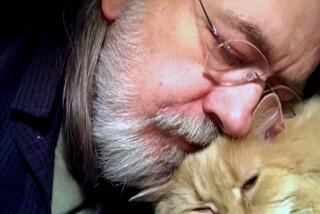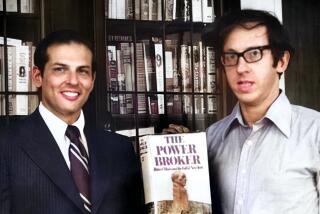A very hungry caterpillar found a hungry readership
- Share via
People who Googled anything on the first day of spring this year were met with a particularly charming version of the search engine’s logo. The Very Hungry Caterpillar, a beloved children’s book character created by Eric Carle in 1969, crawled across the page, eating holes in letters brilliantly colored in characteristic collage style. The only other children’s literature icon the Internet giant has deemed recognizable enough to grace its opening search page? Dr. Seuss.
No wonder. “The Very Hungry Caterpillar,” celebrating its 40th year in print in the same year its creator celebrates his 80th year, has sold 29 million copies in 45 languages. Among the 70 or so books Carle has written and illustrated, it holds a special place. Every 30 seconds, somewhere in the world, a copy of the book is sold, and its publisher, Penguin, crows.
Crowing penguins are something you won’t find in an Eric Carle book. His stories combine scientific accuracy with emotional resonance, a winning combination for the preschool set.
Carle is the featured illustrator at the Los Angeles Times Festival of Books this year. Speaking by phone from his home in the Florida Keys, the author tries to explain his lasting appeal: “I’m very serious about my work. I know how, for young children growing up, it’s not always easy. A helping hand is important. Honesty is important. Not to confuse is important. Humor can’t be too subtle, or it’s confusing.”
“He’s very good at remembering how he felt as a child,” says Carle’s longtime editor, Ann Beneduce. “I can’t remember kindergarten at all, but he can go back to his childhood and feel it. He remembers that fear, when you change grades: ‘Will I have a friend?’ ”
Carle’s books also often make a connection with developmentally disabled kids. One teacher wrote Carle to say she has a student who does not speak at all except to say “Eric Carle.” “It gives you the chills, doesn’t it?” the author asks, adding modestly, “I don’t know what it means.”
Carle’s empathy comes from his own memories of grappling with change in childhood. He was born in Syracuse, N.Y., to German immigrants, but in 1935, his grandmother persuaded the family to return to Germany, assuring them that the dreadful post- World War Iyears of hunger and chaos were over, that things were on the mend.
“They soon realized it was a big mistake,” Carle says in his melodious, gently accented voice. “Those were different days. Travel was difficult, and people didn’t have the money to just turn around and go back.” Carle says he became “an educational expert,” going from kindergarten in one country to first grade in another. “It was a stark contrast at an early age.”
He was an unenthusiastic student, but loved art classes: “When I was 12 or 13, a teacher secretly showed me reproductions of modern artists, impressionists, expressionists -- I always say Picasso, but really, I don’t know who they were. In some ways I was shocked. This teacher was supposed to teach realism, naturalism, Aryans with flags waving. That was art. Of course he told me not to tell anyone. He was very brave. I was shocked by the distorted figures, the green faces. I couldn’t imagine how you could paint such pictures! But it was a very important event for me.”
After graduating from art school in Stuttgart, Germany, Carle returned to the U.S. at age 22 and got a job in advertising. Like ads, “each page of my books is a poster, an image that you quickly grasp. Most of my images are frontal or side views. Somebody once compared me to a cave painter, which I like very much.”
Early on, he also developed the tissue-paper collage technique that gives his work such luminous colors. “When I studied art, we had a class in which we prepared our own paper. We started with a white sheet, and on one side stood a pot of green paint and a pot of red. We made a paper first all green, then a paper with one dot of red, then two drops of red, and so on, to teach the relationships of colors, like finger exercises for pianists.” He keeps hundreds of painted sheets in flat files in his studio. “This is my palette. When I want to make a collage, I choose among them.”
One day an advertisement he had designed caught the eye of Bill Martin Jr., who asked Carle to illustrate his children’s book “Brown Bear, Brown Bear, What Do You See?” The 1967 collaboration was an instant classic; it’s hard to imagine Martin’s text without Carle’s pictures.
Carle loved the project. He had illustrated a children’s book for an educational publisher, but it was, Carle says, “awful stuff! The publisher kept saying: ‘Educational experts have worked on this!’ Bill Martin was totally the opposite. With the educational publisher, there were 32 ideas on one page. With Bill Martin it was 32 pages and one idea.”
This principle of simplicity was a turning point. While working on “Brown Bear,” he asked himself: “What if I were a writer? What would I do? I developed dummies, ideas, and kept them in a cardboard box. I quit my job to be a freelance illustrator and designer.”
One of his loves was book covers -- “little posters,” he calls them -- and he began shopping his portfolio around to publishers. At World Publishing, he found Beneduce, the editor who would become a lifelong collaborator and friend.
“I was very interested in the art world of the 1960s; with pop art and op art, art had become fun,” Beneduce recalls. “When children looked at magazines, they were exposed to bright color, a more simplified kind of art. They were ready for it in children’s books, and I wasn’t finding the artists who could produce it. When I saw Eric’s work, I knew it was exactly what I wanted.”
Carle told Beneduce that he had a box full of ideas. “I persuaded him to come have lunch with me and show me the box,” Beneduce says. “He was still very timid about his English. The first book that came out of the box -- ‘1, 2, 3 to the Zoo’ -- had no words.”
The next book Carle brought her was called “A Week with Willi Worm.” It had clever cutouts in the pages where the worm ate his way through things -- the result of idle doodling with a hole punch -- but Beneduce wasn’t convinced. “I didn’t think a worm was terribly appealing. And it didn’t have an ending. The worm ate, he didn’t feel well, he went to sleep. That was where I said, ‘Let’s try a caterpillar,’ and we were so in tune with each other, I didn’t have to finish my sentence. Eric said ‘BUTTERFLY!!’ It took him not two days, practically overnight, to finish the book.”
The problem then was how to produce the book. The complexity of the cutout holes, and lining them up so that they ran through the book -- so generations of children could make the caterpillar by poking their fingers through -- made the project prohibitively expensive, but while vacationing in Japan, Beneduce found a printer who could make it work.
Clever physical design has always been a hallmark of Carle’s work. His books have contained tabs, cutouts, pages that unfold, even light and sound -- although the 40th anniversary edition of “The Very Hungry Caterpillar” is his first true pop-up made from his work.
Carle explains that there are two reasons for the formats: “As a graphic designer, you always try to surprise. When I worked in advertising, we always tried to design the package in exciting ways. It clicked, or something jumped up.
“The other thing is that children like to touch things. They are still in the world of toys and holding hands. My books are half toy, half book.”
“I often say,” Carle adds, “that my books are made for two days in a child’s life: the last day at home and the first day of school. Home is touching, and warmth, and the familiar, and school is something surprising, something new.”
Carle will be at the Los Angeles Times Festival of Books at UCLA signing merchandise at 11 a.m. Saturday in the Los Angeles Times Pavilion. He also will appear on the Target Children’s Stage at 2:40 p.m. Saturday.
More to Read
The biggest entertainment stories
Get our big stories about Hollywood, film, television, music, arts, culture and more right in your inbox as soon as they publish.
You may occasionally receive promotional content from the Los Angeles Times.










